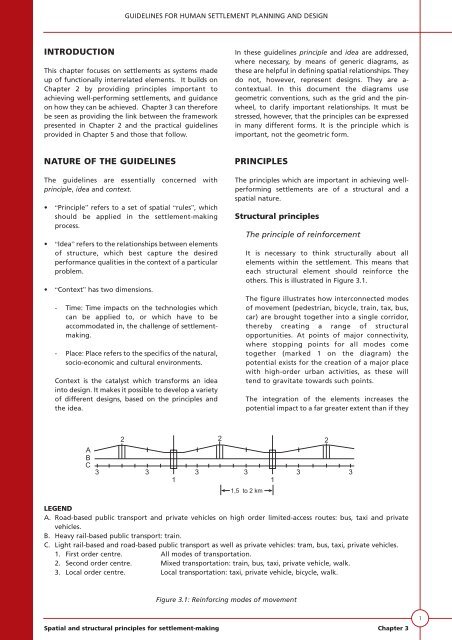VOLUME 1 HUMAN SETTLEMENT PLANNING AND ... - CSIR
VOLUME 1 HUMAN SETTLEMENT PLANNING AND ... - CSIR
VOLUME 1 HUMAN SETTLEMENT PLANNING AND ... - CSIR
- No tags were found...
Create successful ePaper yourself
Turn your PDF publications into a flip-book with our unique Google optimized e-Paper software.
GUIDELINES FOR <strong>HUMAN</strong> <strong>SETTLEMENT</strong> <strong>PLANNING</strong> <strong>AND</strong> DESIGNINTRODUCTIONThis chapter focuses on settlements as systems madeup of functionally interrelated elements. It builds onChapter 2 by providing principles important toachieving well-performing settlements, and guidanceon how they can be achieved. Chapter 3 can thereforebe seen as providing the link between the frameworkpresented in Chapter 2 and the practical guidelinesprovided in Chapter 5 and those that follow.In these guidelines principle and idea are addressed,where necessary, by means of generic diagrams, asthese are helpful in defining spatial relationships. Theydo not, however, represent designs. They are a-contextual. In this document the diagrams usegeometric conventions, such as the grid and the pinwheel,to clarify important relationships. It must bestressed, however, that the principles can be expressedin many different forms. It is the principle which isimportant, not the geometric form.NATURE OF THE GUIDELINESThe guidelines are essentially concerned withprinciple, idea and context.• “Principle” refers to a set of spatial “rules”, whichshould be applied in the settlement-makingprocess.• “Idea” refers to the relationships between elementsof structure, which best capture the desiredperformance qualities in the context of a particularproblem.• “Context” has two dimensions.- Time: Time impacts on the technologies whichcan be applied to, or which have to beaccommodated in, the challenge of settlementmaking.- Place: Place refers to the specifics of the natural,socio-economic and cultural environments.Context is the catalyst which transforms an ideainto design. It makes it possible to develop a varietyof different designs, based on the principles andthe idea.PRINCIPLESThe principles which are important in achieving wellperformingsettlements are of a structural and aspatial nature.Structural principlesThe principle of reinforcementIt is necessary to think structurally about allelements within the settlement. This means thateach structural element should reinforce theothers. This is illustrated in Figure 3.1.The figure illustrates how interconnected modesof movement (pedestrian, bicycle, train, tax, bus,car) are brought together into a single corridor,thereby creating a range of structuralopportunities. At points of major connectivity,where stopping points for all modes cometogether (marked 1 on the diagram) thepotential exists for the creation of a major placewith high-order urban activities, as these willtend to gravitate towards such points.The integration of the elements increases thepotential impact to a far greater extent than if they2 2 2ABC3 3 3 3 3 3111,5 to 2 kmLEGENDA. Road-based public transport and private vehicles on high order limited-access routes: bus, taxi and privatevehicles.B. Heavy rail-based public transport: train.C. Light rail-based and road-based public transport as well as private vehicles: tram, bus, taxi, private vehicles.1. First order centre. All modes of transportation.2. Second order centre. Mixed transportation: train, bus, taxi, private vehicle, walk.3. Local order centre. Local transportation: taxi, private vehicle, bicycle, walk.Figure 3.1: Reinforcing modes of movementSpatial and structural principles for settlement-making Chapter 31
















